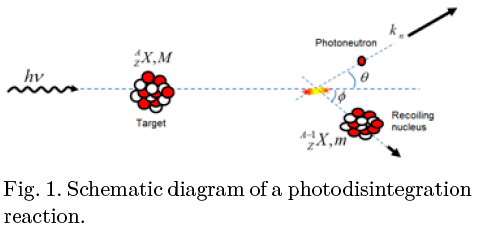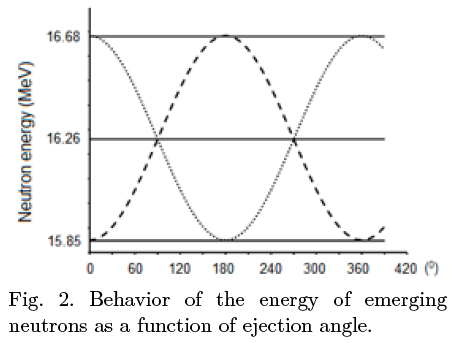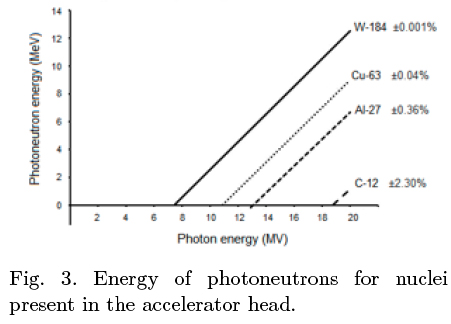Services on Demand
Journal
Article
Indicators
-
 Cited by SciELO
Cited by SciELO -
 Access statistics
Access statistics
Related links
-
 Similars in
SciELO
Similars in
SciELO
Share
Revista mexicana de ingeniería biomédica
On-line version ISSN 2395-9126Print version ISSN 0188-9532
Rev. mex. ing. bioméd vol.34 n.2 México Aug. 2013
Artículos de investigación
Kinetic Energy of Emerging Neutrons Produced by Photodisintegration in a Medical Linear Accelerator
Energía cinética de neutrones emergentes producidos por fotodesintegración en un acelerador médico lineal
U. Reyes*, M. Sosa*, J. Bernal*, T. Córdova*, F. Mesa**
* Department of Physical Engineering, Division of Science and Engineering, University of Guanajuato, Leon, Gto., Mexico.
** Polytechnic University of Victoria, Ciudad Victoria, Tam., Mexico.
Correspondencia:
M. Sosa,
Loma del Bosque 103,
Lomas del Campestre 37150,
León, Guanajuato México,
Correo electrónico: modesto@fisica.ugto.mx
Fecha de recepción: 29 de Noviembre de 2012
Fecha de aceptación: 15 de Mayo de 2013
ABSTRACT
When a gamma photon interacts with a target nucleus a nuclear reaction can be generated, producing as a consequence the expulsion of particles from the atomic nucleus, this process is called photodisintegration. For this work, are of interest nuclear reactions of photodisintegration in which neutrons are ejected due to the interaction of photons with atomic nuclei of different materials in a linear accelerator for medical use. In this paper, the kinetic energy of photoneutrons produced by interactions with atomic nuclei of 184W, 63Cu, 27Al and 12C, which are some of the materials that constitute the head of a medical linear accelerator, is calculated. Also, the nuclei present in the construction materials of the room and the maze of the accelerator, such as, 23Na, 40Ca and 28Si, as also in the human body, 2H, 14N and 16O, are considered. It derives an exact theoretical expression, which has a linear dependence of the energy of the produced neutrons relative to the incident photon energy. It is found that, in the majority of cases, just photons with energies above 10 MV contribute to the production of neutrons. The values calculated from the expression obtained in this work are in good agreement with those reported in the literature, that are obtained by other approaches.
Keywords: photoneutrons, kinetic energy, linear accelerator, photodisintegration.
RESUMEN
Cuando un fotón gamma interactúa con un núcleo blanco una reacción nuclear puede ser generada, produciendo como consecuencia la expulsión de partículas del núcleo atómico, este proceso se denomina fotodesintegración. Para este trabajo, son de interés las reacciones nucleares de fotodesintegración en las que los neutrones son expulsados debido a la interacción de los fotones con los núcleos atómicos de diferentes materiales en un acelerador lineal para uso médico. En este trabajo, la energía cinética de fotoneutrones producidos por la interacción con los núcleos atómicos de 184 W, 63 Cu, 27 Al y 12 C, que son algunos de los materiales que constituyen el cabezal de un acelerador lineal médico, es calculada. Además, los núcleos presentes en los materiales de construcción de la sala y el laberinto del acelerador, como por ejemplo, 23Na, 40Ca y 28Si, como también en el cuerpo humano, 2H, 14N y 16O, son considerados. Se obtiene una expresión exacta teórica, la cual tiene una dependencia lineal de la energía de los neutrones producidos en relación a la energía del fotón incidente. Se ha encontrado que, en la mayoría de los casos, sólo los fotones con energías por encima de 10 MV contribuyen a la producción de neutrones. Los valores calculados a partir de la expresión obtenida en este trabajo están en buen acuerdo con los reportados en la literatura, los cuales se obtienen mediante otros métodos.
Palabras clave: fotoneutrones, energía cinética, acelerador lineal, fotodesintegración.
INTRODUCTION
The energies binding the nucleons inside the nucleus are very large. However, when particles such as neutrons, protons, alpha particles, or high energy photons collide with atomic nuclei, they can produce changes within it. During these interactions can occur several events: sometimes the incident particle enters the nucleus, where it remains, while a second particle, or many more, are expelled. In other cases, the incident particle can get to fracture the nucleus into several parts, or simply can bounce in an elastic collision. The stability of the atomic nuclei is measured in terms of the energy of the incident particle and the Q factor of the reaction.
Within the range of particles used as projectiles in nuclear reactions are the photons. Their ways of interaction with matter include: the photoelectric effect, pair production and Compton effect. However, by its charge neutrality, photons can also cross the electron cloud to interact with atomic nuclei, producing nuclear reactions. Such reactions are known as photodisintegration reactions and are vital when you want to analyze the spectrum of neutrons produced in a medical linear accelerator. The neutrons released by this type of nuclear reactions are known as photoneutrons.
Linear accelerators are a modern tool widely used in medicine for radiotherapy treatments. In recent years, the accelerators have replaced the use of 60Co sources, when required irradiation is with high-energy photons. An advantage thereof is that there is a controlled radiation emitter, unlike a radioactive source having a constant rate of emission. However, when a linac is used in the photon mode, contamination arises due to neutrons produced by photodisintegration, when the photons of the beam interact with the material of the accelerator head itself as well as with the building materials of the walls, and finally with the patient himself. These neutrons present a complex spectrum of energies that depends on the energy of the incident photons, the cross section of the materials which interact with photons, the same energy distribution of the photon beam and the production of thermal neutrons, as well as other possible mechanisms of neutron production. Meanwhile, the determination of the neutron contamination is important because the generated neutrons may interact in many cases with the patient, producing secondary charged particles that can contribute as an additional dose, which is generally not taken into account in the design of protocols for radiotherapy treatments. In the literature, this problem has been addressed by several authors, which raises the need to develop methods [1-6], both experimental and computational, that allow the determination of the neutron energy spectrum, and from this calculate the dose deposited. On the other hand, it is known, theoretically, that the production of neutron in photodisintegration reactions is possible only if the energy of the incident photons exceeds the Q value of the nuclear reaction. Similarly, in the neutron energy spectrum, the neutron peak corresponding to the primary neutrons, that is, those generated by the incident photons is relatively pronounced [5]. This part of the spectrum is particularly interesting since contains fast neutrons, which are able to produce secondary ionizing particles; they deliver most of the total neutron dose along the beam axis [7-9].
Due to the above, this paper addresses the problem of calculating the kinetic energy of the emerging neutrons, for which it had been derived an exact expression, which has a linear dependence of the photoneutrons energy with the incident photon energy; also, such formula is applied to the nuclei of the various materials present in a radiation room, including the patient. No consideration of the cross section has been made, because this last parameter is only relevant when obtaining the energy spectrum of neutrons, not their kinetic energy due to the reaction.
CALCULATION OF THE ENERGY
Suppose we have the following photodisintegration reaction:

which is shown schematically in Figure 1. In the first scene, we have a photon with energy hv which hits a nucleus of mass M, which is at rest. Then, a recoiling nucleus with mass m and kinetic energy k, as also a photoneutron of kinetic energy kn, are ejected at angles Φ and θ, respectively.

Hence, applying mass-energy conservation, we have

from which the Q factor of the reaction is given by

Then, applying conservation of momentum, one obtains the following equation

It has two solutions for Eq. (5), and both have an average value given by  From the above equations, and after some algebra, yields an expression for the kinetic energy of the photoneutron, as a function of incident photon momentum, given by
From the above equations, and after some algebra, yields an expression for the kinetic energy of the photoneutron, as a function of incident photon momentum, given by

where the sign ± is a consequence of the angle at which the photoneutron emerges.
It can be seen that Eq. (5) has two solutions for the momentum of the photoneutron. When considering the positive root in Eq. (5), the solution has a sinusoidal behavior shown in Figure 2 (dotted line). If one considers an angle of θ = 0°, there is a maximum in the energy of photoneutrons. The minimum is obtained for θ = 180°. However, considering the negative root (dashed line), there is a minimum to θ = 0° and a maximum at θ = 180°. This means that the two solutions have a phase shift of Π in the ejection angle of the photoneutron.

For the calculation of the energies shown in Figure 2, has been considered an atomic nucleus of 9Be, at rest, and a photon of 20 MV. The two curves indicate the behavior of the photoneutron energy, depending on the emerging angle θ. The three horizontal lines show the average, maximum and minimum, respectively, of the expected energy of the photoneutron without dependency on the angle. The middle line (average energy) corresponds to the first two terms of Eq. (6). The other two horizontal lines correspond to the third term of this equation, for the positive (maximum energy) and negative sign (minimum energy), respectively.
MATERIAL AND METHODS
The expression given by Eq. (6), to the output energy of the neutrons produced by photodisintegration in a medical linear accelerator has been applied to various materials present in the accelerator head. Specifically in the head of a linac for medical use, there are nuclei of 206Pb, 207Pb, 208Pb, 180W, 182W, 183W, 184W, 27Al, 63Cu, 65Cu, 54Fe, 56Fe and 57Fe, among others. All these elements have a nuclear reaction Q factor different from each other. Furthermore, they present a different isotopic abundance, which is given as a percentage, in parentheses.
Likewise, for the purposes of determining the additional dose in patients due to neutrons produced in a linac, during radiotherapy treatment, it is extremely important to know not only the nuclei present in the accelerator head, but also atomic nuclei constituents of the human body that can generate neutrons. Among these elements are primarily 2H, 14N, 16O, 12C and 40Ca.
Similarly, even the maze building materials, and even the air, contains elements that should be considered possible source of neutron production by photodisintegration. Nuclei such as 23Na, 40Ca, 16O and 28Si can be found in these materials.
The behavior of the emerging neutron energy produced by photons of different energies from a linac, interacting with the above materials, has been obtained by applying Eq. (6), and plotted below.
RESULTS AND DISCUSSION
Figure 3 shows the behavior of the kinetic energy of the neutrons, generated by interaction of photons with atomic nuclei of 184W (30.7%), 63Cu (69.17%), 27Al (100%) and 12C (98.89%) in the accelerator head. All curves shown are the result of evaluating Eq. (6), for different incident photon energies. Clearly, a neutron can be generated if the incident photon energy is higher than the Q factor of reaction for each atomic nucleus. It can be observed that are required, in most cases, photons with energies above 10 MV, for neutron generation becomes important.

Furthermore, there is a linear dependence of the neutron energy with the incident photon energy. The figure also shows the maximum value, with sign ±, obtained by evaluating the third term in Eq. (6), for each of the elements considered.
For its part, Figure 4 shows curves of the energy of photoneutrons for nuclei present in the human body. The graph confirms the linear dependence on the incident photon energy. Also, can be observed that are required photons with energies above 10 MV to have neutron generation, except for 2H, in which case, photons of energy just above 2 MV are required to initiate the reaction, and hence the production of photoneutrons.

Finally, we show in Figure 5 the curves that describe the behavior of the photoneutron energy for atomic nuclei of the materials present in the maze of the linac and even the air. It can be seen that as in the previous cases, are required high energy photons, in this case greater than 12 MV for the production of photoneutrons occurs.

Previous results allow observing that only in those cases in which treatments are conducted with photons with energies above 10 MV, there is a high probability that neutrons are produced by the interaction of the photons with the materials of the medium. It is therefore in these treatments where more attention should be paid to the calculation of additional dose due to neutrons.
Finally, note that this problem is addressed in the literature in various ways: Through experimental measurements of neutron spectrum, computer simulation, and, as in the case of this work, taking as its starting point the theoretical analysis of the energy of the photoneutrons generated by photodisintegration, which leads to the origin of the problem, that is, the discussion on the feasibility of the occurrence of a sea of neutrons in the treatment room, which may eventually result in an additional dose to the patient. Thus, the present type of calculation can provide useful information regarding a review of the philosophy and the criteria by which these processes are carried out. Therefore, the medical contribution of this kind of analysis must be viewed to be a basis for questions such as: How likely is the generation of neutrons in a given treatment with photons?, how feasible is that such procedures be carried out, without reducing its effectiveness at a lower beam energy, thus reducing the likelihood of a dose added to the patient? These are basic questions to be addressed, especially taking into account that according to the Mexican Social Security Institute, in a specialized hospital with a Varian linear accelerator 2100Ex, between the years 2011 and 2012 were performed 1180 treatments, of which 38.6% was carried out with photons of 18 MV, 50.4% with 6 MV photons and the rest with various electron energies between 4 and 15 MeV.
CONCLUSIONS
Linear accelerators for medical use with photons of energies greater than 10 MV, are capable of generating neutrons by nuclear reactions. These photoneutrons occur as a result of the incident photon interaction with nuclei of materials present in the linac head, as well as on the walls of the maze, the air and even the patient.
We analyzed the reaction of photodisintegration produced when photons of a LINAC interact with environmental materials. In this paper we have considered only the dependence with the incident photon energy. In this regard it should be noted that even when photons have higher energy than the Q factor of the reaction, this is not sufficient to produce photoneutrons. The other factor which indicates the generation of photoneutrons is the cross section. However, for the calculation presented here, the cross section does not affect the result, as this only affects the probability that the reaction occurs. What is affected by the cross section is the energy spectrum of the neutrons. Thus, this paper derives an exact theoretical expression for the calculation of the kinetic energy of the neutrons emerging from the reaction. The results show a linear dependence on energy of the incident photons, and are in good agreement with other results published in the literature by using different approaches [3,10].
REFERENCES
1. Lin JP, Chu TC, Lin SY, Liu MT. "The measurement of photoneutrons in the vicinity of a Siemens Primus linear accelerator". Applied Radiation Isotopes 2001; 55(3): 315-321. [ Links ]
2. Kim HS, Park YH, Koo BC, Kwon JW, Lee JS, Choi HS. "Evaluation of the photoneutron field produced in a medical linear accelerator". Radiation Protection Dosimetry 2007; 123(3): 323-328. [ Links ]
3. Chin MPW. Neutron contamination in a radiotherapy maze. M.Sc. in Medical Physics Thesis. University of Surrey, China, 1999. [ Links ]
4. Facure A, Falcao RC, Da Silva AX, Crispim VR, Vitorelli JC. "A study of neutron spectra from medical linear accelerators". Applied Radiation Isotopes 2005; (62)1: 69-72. [ Links ]
5. Ongaro C, Zanini A, Nastasi U, Ródenas J, Ottaviano G, Manfredotti C. "Analysis of photoneutron spectra produced in medical accelerators". Phys. Med. Biol. 2000; (45)12: L55-L61. [ Links ]
6. Barquero R, Mendez R, Vega-Carrillo HR, Iñiguez MP, Edwards TM. "Neutron spectra and dosimetric features around an 18 MV linac accelerator". Health Phys. 2005; 88(1): 48-58. [ Links ]
7. d'Errico F, Nath R, Tana L, Curzio G, Alberts WG. "In-phantom dosimetry and spectrometry of photoneutrons from an 18 MV linear accelerator". Med. Phys. 1998; 25(9): 1717-1724. [ Links ]
8. Facure A, Falcao RC, Da Silva AX, Crispim VR. "Neutron dose rate evaluation for medical linear accelerators". Radiation Protection Dosimetry 2004; 111(1): 101-103. [ Links ]














